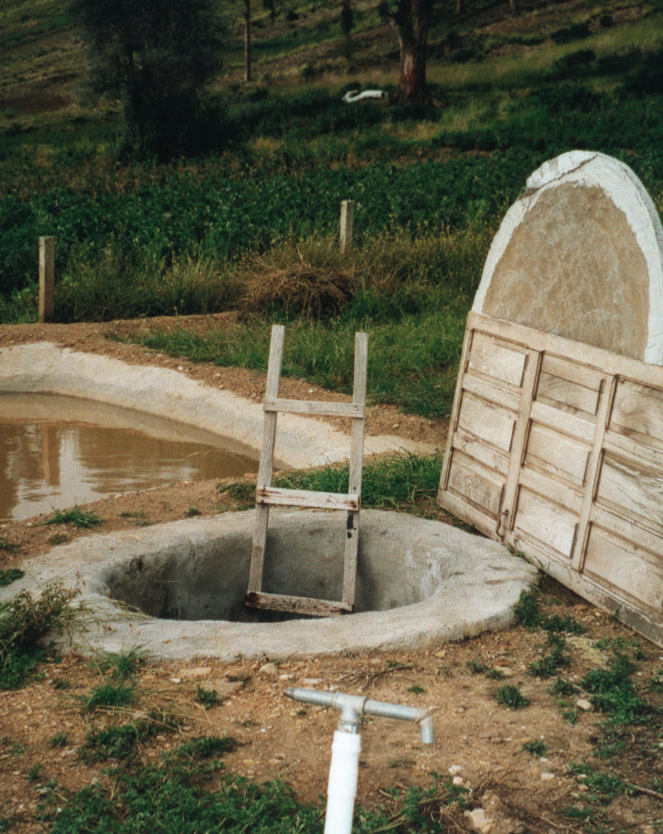Difference between revisions of "Underground tank"
(icon and picture) |
(text and pict.text) |
||
| Line 1: | Line 1: | ||
[[Image:Underground_tank_icon.png|right]] | [[Image:Underground_tank_icon.png|right]] | ||
| − | + | Where access to groundwater is limited, rainwater harvesting in underground tanks can be an effective and low-cost solution. Water stored in the rainy season can be used in the dry season and lifted from the tank with a rope pump or with a FlexiEmas pump (see PVC pumps), which can elevate water up to 30 m. The government, with support from organisations such as UNICEF and IRCSA (International Rainwater Catchment Systems Association) started a programme to construct one million rainwatertanks in Brazil. Practica foundation is testing various options for low-cost storage and groundwater recharge like the "Reed cement tank" and the "Tube recharge" | |
| − | [[Image:Underground_tank.PNG|thumb|right|150px| | + | [[Image:Underground_tank.PNG|thumb|right|150px|Underground storage of rainwater in Bolivia ]] |
{| border="1" cellpadding="5" cellspacing="0" align="center" | {| border="1" cellpadding="5" cellspacing="0" align="center" | ||
| Line 14: | Line 14: | ||
Easy to train on maintenance. | Easy to train on maintenance. | ||
| valign="top" | Not all introduction programs have been successful.<br> | | valign="top" | Not all introduction programs have been successful.<br> | ||
| + | |} | ||
| + | |||
| + | |||
| + | == Capacity == | ||
| + | |||
| + | 40 litres / min from 10 meters depth. | ||
| + | |||
| + | == Costs == | ||
| + | |||
| + | * US$ 20-120 depending on model. | ||
| + | |||
| + | == Applying conditions == | ||
| + | <ul> | ||
| + | <li><b>Numbers:</b> 50,000 in Nicaragua, 20,000 in Mexico, Honduras, Guatemala, Ghana, Zimbabwe, Tanaznia, Senegal.</li> | ||
| + | <li><b>Range of depth:</b> 1-35 meter (60 m with two cranks).</li> | ||
| + | <li><b>Application</b> Communal wells, houshold, irrigation. </li> | ||
| + | <li><b>Cost of introduction:</b> US$ 10,000-20,000 per project, including 20 pumps, engineering and hands-on training. US$ 60,000-100,000 per project, including 1,000 pumps, production workshop and hands-on training.</li> | ||
| + | </ul> | ||
| + | |||
| + | == Rope pump building manual == | ||
| + | |||
| + | PRACTICA foundation and the Technical Training Programme of the ETC Foundation (TTP/ETC) have put together a really [http://www.greenocean.org/akvo/PRACTICA_180306_Rope_pump_manual_Ethiopia_March_2006_complete.pdf excellent manual on how to build rope pumps] (PDF, 2.5 Mbyte). It is an 86 page long document with detailed instructions. | ||
| + | |||
| + | == External links == | ||
| + | * Evaluations [http://www.irc.nl www.irc.nl ] | ||
| + | * Africa [http://www.pumpaid.org www.pumpaid.org ] | ||
| + | * General info [http://www.ropepump.com www.ropepump.com] | ||
| + | * How to build [http://www.ropepumps.org www.ropepumps.org] | ||
Revision as of 21:55, 29 July 2007
Where access to groundwater is limited, rainwater harvesting in underground tanks can be an effective and low-cost solution. Water stored in the rainy season can be used in the dry season and lifted from the tank with a rope pump or with a FlexiEmas pump (see PVC pumps), which can elevate water up to 30 m. The government, with support from organisations such as UNICEF and IRCSA (International Rainwater Catchment Systems Association) started a programme to construct one million rainwatertanks in Brazil. Practica foundation is testing various options for low-cost storage and groundwater recharge like the "Reed cement tank" and the "Tube recharge"
| Advantages | Disadvantages |
|---|---|
| Significantly cheaper than piston pumps. Easy to maintain. |
Not all introduction programs have been successful. |
Capacity
40 litres / min from 10 meters depth.
Costs
- US$ 20-120 depending on model.
Applying conditions
- Numbers: 50,000 in Nicaragua, 20,000 in Mexico, Honduras, Guatemala, Ghana, Zimbabwe, Tanaznia, Senegal.
- Range of depth: 1-35 meter (60 m with two cranks).
- Application Communal wells, houshold, irrigation.
- Cost of introduction: US$ 10,000-20,000 per project, including 20 pumps, engineering and hands-on training. US$ 60,000-100,000 per project, including 1,000 pumps, production workshop and hands-on training.
Rope pump building manual
PRACTICA foundation and the Technical Training Programme of the ETC Foundation (TTP/ETC) have put together a really excellent manual on how to build rope pumps (PDF, 2.5 Mbyte). It is an 86 page long document with detailed instructions.
External links
- Evaluations www.irc.nl
- Africa www.pumpaid.org
- General info www.ropepump.com
- How to build www.ropepumps.org

